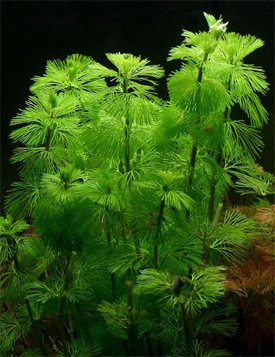
 Magyarul / Hungarian
Magyarul / Hungarian


- Scientific name: Cabomba aquatica
- Synonym: Nectris aquatica
- Common name: Yellow cabomba, Giant cabomba
- Family: Cabomboicleae
- Group: Aquarium plants
- Max height: 40 cm (somethimes 60 cm).
- Distribution: Northern and central South America.
- Habitat: Grows in the lower to upper catchment area of the Rio Negro (Brazil), as well as in strong-current and lake-like waters without noticeable water movement.
- Substrate: Nutrient rich substrate
- Placement in aquarium: Background
- Lighting needs: Very bright
- Temperature: 24-28°C
- pH: 6,5-7
- Hardness: 4-6NK°
Description: This attractive plant produces many fine, feathery leaves. The yellow-green coloration is unusual and makes for an interesting ornamental plant. Due to the very fine nature of the leaves, it is vital that the water is clean and free from floating debris, and that algae is not allowed to form on the plant. Strong lighting is required to keep it looking healthy and compact. Sterms should be planted in small groups in open areas, and at least 5-6 cm apart, so that light can reach the lower leaves. The plant prefers water with a low pH (6-7).
There exist very different forms of Cabomba aquatica, known as the giant Cabomba, this green, under intense light also slightly red plant is often available from aquarium shops and has an especially high decorative status. It is, however, difficult to keep in the long run. A preferably salt-deficient, soft, moving water with a pH-value within the slightly acid range and a temperature of 23—25 °C is important. Light intensity has to be very high. Under optimum conditions, it is not uncommon for the plant to develop floating leaf shoots with trimerous flowers; fruit, too, can then be observed. The reddish plants with dimerous flowers, know as Cabomba aquatica "schwartzii," don't display a satisfactory growth in cultivation due to their extreme ecological requirements.








